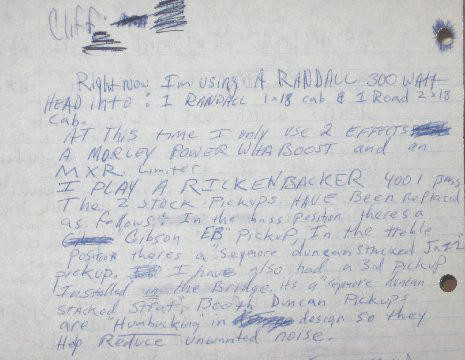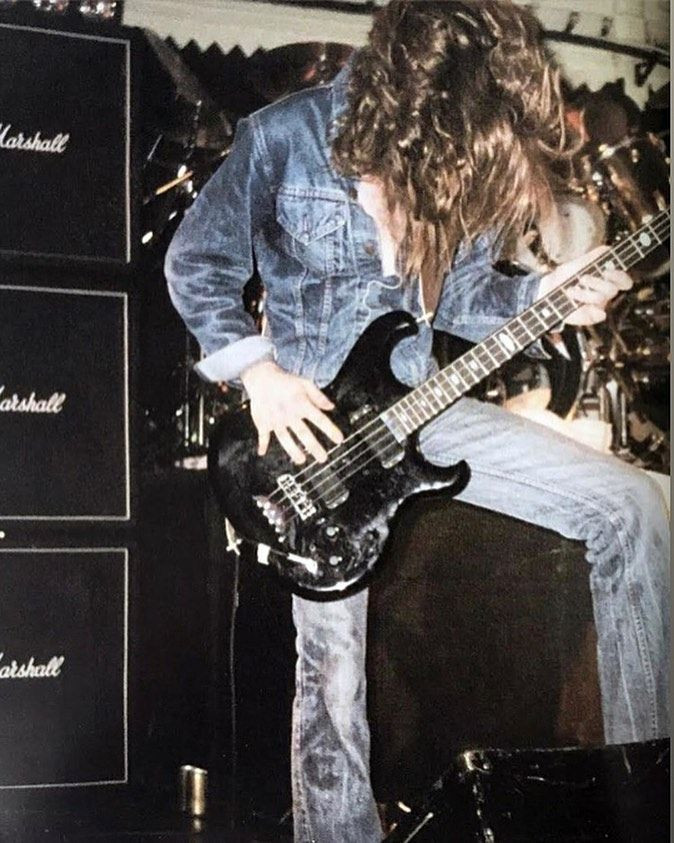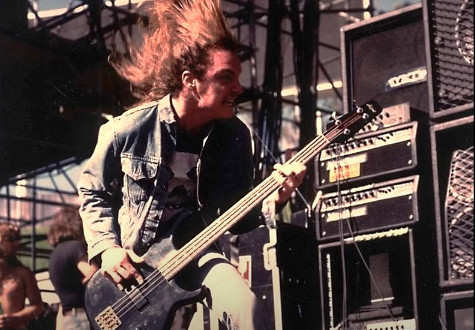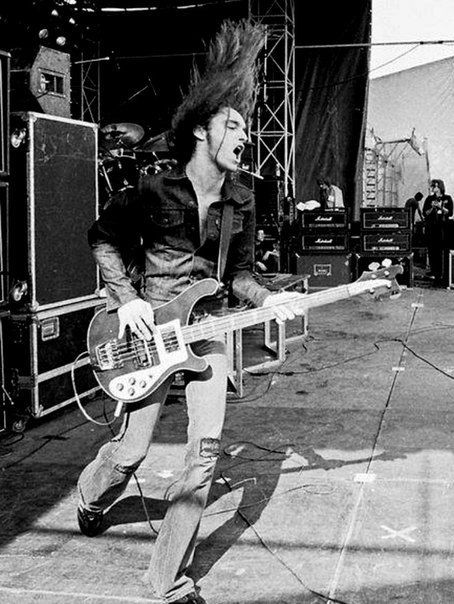Love them or hate them, Metallica’s output during the 1980s is undeniably brilliant. Their combination of fast-paced drumming and melodic riffs essentially created the heavy metal template for the next two decades. This achievement would have been impossible without the groundbreaking contributions of their original bassist, Cliff Burton.
From Kill ‘Em All to Master of Puppets, Cliff Burton’s masterful bass playing and extensive musical knowledge were crucial in propelling Metallica to both critical acclaim and mainstream success. Tragically, Burton’s life was cut short in 1986 due to a tour bus accident in Sweden. Despite his brief time with the band, his era is widely considered Metallica’s finest. He inspired countless metal musicians worldwide and cemented his place as one of the 20th century’s greatest bassists.
To honor this legend, we delve into the gear that shaped Cliff Burton’s iconic sound and forever changed the landscape of heavy metal music.
Rickenbacker 4001 Bass Guitar
Cliff Burton’s primary bass when he joined Metallica in 1982 was a red Rickenbacker 4001. This Cliff Burton Bass Guitar was instrumental in recording Metallica’s debut album Kill ‘Em All in 1983 and the subsequent ‘Kill ‘Em All For One’ tour. It also featured on several bass parts of 1984’s Ride The Lightning before being retired due to technical issues.
Burton famously modified his Rickenbacker 4001 to accommodate his heavy use of effects pedals and powerful fingerstyle bass playing. He replaced the original Rickenbacker pickups, installing a Gibson EB ‘mudbucker’ humbucker in the neck position and a Seymour Duncan Stacked Jazz Bass pickup in the bridge. These modifications were key to achieving his signature cliff burton bass guitar tone.
A handwritten note from Burton reveals his initial experimentation with a third stacked Seymour Duncan Stratocaster pickup. This was placed where the Rickenbacker’s foam mute was, activated by a push-pull knob. This modification acted as a noise suppressor and a secret weapon for the aggressive bass showcase ‘(Anaesthesia) Pulling Teeth’ on Kill ‘Em All.
 Cliff Burton handwritten note
Cliff Burton handwritten note
Handwritten note by Cliff Burton detailing modifications to his Rickenbacker 4001 bass guitar.
Aria Pro SB Black N’ Gold Bass Guitar
Around 1985, Cliff Burton secured an endorsement deal with Japanese instrument manufacturer Aria. He initially played an Aria Pro SB1000 before receiving his signature Aria SB Black n’ Gold bass. This cliff burton bass guitar quickly became his preferred instrument.
The Aria SB Black n’ Gold saw extensive use both in the studio and live performances from 1985-86, most notably during the recording of the seminal Master Of Puppets album. This cliff burton bass guitar is heavily associated with his most iconic era.
In 2013, Aria paid tribute to Burton by releasing a signature model based on the exact specifications of his SB Black n’ Gold. This signature cliff burton bass guitar allows fans to capture a piece of his legendary sound.
 Cliff Burton Aria Bass
Cliff Burton Aria Bass
Cliff Burton playing his Aria SB Black N’ Gold bass guitar during a live Metallica performance.
Alembic Spoiler II Bass Guitar
Between the albums Kill ‘Em All and Ride The Lightning, Burton used a highly sought-after early 1980s Alembic Spoiler II bass guitar for various live performances. This instrument was equipped with dual AXY4 pickups. Sadly, this cliff burton bass guitar was stolen from Burton’s car in late 1985, and its current whereabouts remain unknown, making it a lost piece of metal history.

Close up view of an Alembic Spoiler II bass guitar, similar to the model used by Cliff Burton in early Metallica days.
Acoustic Guitar
Beyond his famed bass guitars, Cliff Burton’s musical contributions extended to other instruments. He played a drop-tuned acoustic guitar on the intro to Ride The Lightning‘s opening track, ‘Fight Fire With Fire’. This showcases his broader musicality beyond just the cliff burton bass guitar.
Metallica’s lead guitarist, Kirk Hammett, highlighted Burton’s influence in a 2016 Guitar World interview: “Cliff went the whole length and learned musical theory and everything. He was way into harmonies. James really absorbed the dual-harmony thing and took it to heart. He made it his thing, but it was originally Cliff’s. Cliff also inspired James greatly on counterpoint and rhythmic concepts. He had a really good grasp of playing the guitar, and a good grasp of classical modulations. That intro was his piece. We heard it and stuck it onto ‘Fight’, and it worked fantastic.” This demonstrates Burton’s significant musical input to Metallica’s songwriting, even beyond his cliff burton bass guitar work.
Mesa Boogie Amplification
The foundation of Burton’s powerful bass tone in Metallica came from his choice of amplification. While early gigs saw him using a Sunn Beta Bass Amp and a Peavey Mark IV Series 400 head with standard cabinets, his signature heavy tone was primarily driven by two valve-powered Mesa Boogie D-180 heads. One head was dedicated to a clean signal, while the other processed his complex effects chain.
Burton typically ran his amp heads into two separate speaker cabinets. Photographic evidence suggests he favored a combination of a Mesa Boogie 4×12″ cabinet paired with a 1×15″ cabinet. This combination allowed him to achieve both punch and low-end fullness in his cliff burton bass guitar sound.
 cliff burton bass amp
cliff burton bass amp
Cliff Burton’s amp setup featuring Mesa Boogie heads and cabinets, crucial for his signature bass tone.
Morely Power Wah Boost Pedal
Cliff Burton was famous for his distinctive use of a wah-wah pedal. He employed a Hendrix-esque approach, using it to filter frequencies and create his sweeping bass solo tones. The Morely Power Wah Boost was a constant fixture on Burton’s pedalboard throughout his Metallica career. Its distinctive sound is prominently featured on Ride The Lightning‘s classic track ‘For Whom The Bell Tolls’, showcasing a key element of the cliff burton bass guitar sound.
Boss CS-2 Compression Sustainer Pedal
To further enhance his powerful fingerstyle bass playing, Burton incorporated a Boss CS-2 Compression Sustainer pedal into his rig. This pedal added extra sustain and volume, contributing to his thunderous bass presence within Metallica’s sound. The Boss CS-2, often seen next to his Morely Power Wah, was integral to sculpting his dynamic cliff burton bass guitar tone.
 Boss CS-2 Compression Sustainer Pedal
Boss CS-2 Compression Sustainer Pedal
The Boss CS-2 Compression Sustainer pedal, a key component in Cliff Burton’s effects pedalboard.
Electro-Harmonix Russian Big Muff Pedal
The unique sonic character of the Russian-made Electro-Harmonix Big Muff pedal played a significant role in shaping Burton’s distorted bass tone on Metallica’s first two albums, Kill ‘Em All and Ride the Lightning. However, around the time of recording and touring Master Of Puppets, he transitioned to an Ibanez TS-808 Tube Screamer overdrive. This switch highlights the evolution of his cliff burton bass guitar tone as Metallica’s music matured.
 Electro-Harmonix Russian Big Muff Pedal
Electro-Harmonix Russian Big Muff Pedal
The Electro-Harmonix Russian Big Muff pedal, crucial for Cliff Burton’s early distorted bass sounds.
Ibanez HD1500 Harmonics/Delay Rack Unit
For creating volume swells in conjunction with his Morely Power Wah, Burton utilized a rack-mounted Ibanez HD1500 Harmonics/Delay effect unit. In a Thrash Metal interview conducted during the Master Of Puppets recording sessions, Burton elaborated on its use.
“On this album there’s an intro to a song called ‘Damage (Inc),’ done all on bass,” he explained. “It’s about eight or 12 tracks of bass, a whole lot of harmonies and volume swells and effects and stuff. I would hesitate to call it a bass solo, it’s more just an intro, but it’s all bass.” This detailed description offers insight into Burton’s innovative approach to bass playing and his pioneering use of effects to create unique textures beyond typical cliff burton bass guitar techniques.
Cliff Burton’s innovative approach to bass playing and his carefully curated gear significantly shaped the sound of Metallica during their most influential period. His legacy continues to inspire bass players across genres, and his contributions to heavy metal remain unparalleled. Exploring his gear provides valuable insight into the techniques and technology behind the iconic cliff burton bass guitar sound that defined an era.
Keep up to date with Metallica here.

